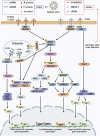Toll-Like Receptor Signaling in Severe Acute Respiratory Syndrome Coronavirus 2-Induced Innate Immune Responses and the Potential Application Value of Toll-Like Receptor Immunomodulators in Patients With Coronavirus Disease 2019
- PMID: 35832809
- PMCID: PMC9271922
- DOI: 10.3389/fmicb.2022.948770
Toll-Like Receptor Signaling in Severe Acute Respiratory Syndrome Coronavirus 2-Induced Innate Immune Responses and the Potential Application Value of Toll-Like Receptor Immunomodulators in Patients With Coronavirus Disease 2019
Abstract
Toll-like receptors (TLRs) are key sensors that recognize the pathogen-associated molecular patterns (PAMPs) of severe acute respiratory syndrome coronavirus 2 (SARS-CoV-2) to activate innate immune response to clear the invading virus. However, dysregulated immune responses may elicit the overproduction of proinflammatory cytokines and chemokines, resulting in the enhancement of immune-mediated pathology. Therefore, a proper understanding of the interaction between SARS-CoV-2 and TLR-induced immune responses is very important for the development of effective preventive and therapeutic strategies. In this review, we discuss the recognition of SARS-CoV-2 components by TLRs and the downstream signaling pathways that are activated, as well as the dual role of TLRs in regulating antiviral effects and excessive inflammatory responses in patients with coronavirus disease 2019 (COVID-19). In addition, this article describes recent progress in the development of TLR immunomodulators including the agonists and antagonists, as vaccine adjuvants or agents used to treat hyperinflammatory responses during SARS-CoV-2 infection.
Keywords: COVID-19; SARS-CoV-2; Toll-like receptor; immunomodulator; innate immune response.
Copyright © 2022 Dai, Wang, Wang, Gao, Wang, Fang, Shi, Zhang, Wang, Su and Yang.
Conflict of interest statement
The authors declare that the research was conducted in the absence of any commercial or financial relationships that could be construed as a potential conflict of interest.
Figures

Similar articles
-
Toll-Like Receptor 3 Signaling via TRIF Contributes to a Protective Innate Immune Response to Severe Acute Respiratory Syndrome Coronavirus Infection.mBio. 2015 May 26;6(3):e00638-15. doi: 10.1128/mBio.00638-15. mBio. 2015. PMID: 26015500 Free PMC article.
-
An Overview of Recent Insights into the Response of TLR to SARS-CoV-2 Infection and the Potential of TLR Agonists as SARS-CoV-2 Vaccine Adjuvants.Viruses. 2021 Nov 18;13(11):2302. doi: 10.3390/v13112302. Viruses. 2021. PMID: 34835108 Free PMC article. Review.
-
TLRs: Innate Immune Sentries against SARS-CoV-2 Infection.Int J Mol Sci. 2023 Apr 29;24(9):8065. doi: 10.3390/ijms24098065. Int J Mol Sci. 2023. PMID: 37175768 Free PMC article. Review.
-
Toll-like receptor (TLRs) agonists and antagonists for COVID-19 treatments.Front Pharmacol. 2022 Sep 7;13:989664. doi: 10.3389/fphar.2022.989664. eCollection 2022. Front Pharmacol. 2022. PMID: 36188605 Free PMC article. Review.
-
Current Understanding of the Innate Control of Toll-like Receptors in Response to SARS-CoV-2 Infection.Viruses. 2021 Oct 22;13(11):2132. doi: 10.3390/v13112132. Viruses. 2021. PMID: 34834939 Free PMC article. Review.
Cited by
-
SARS-CoV-2 modulates inflammatory responses of alveolar epithelial type II cells via PI3K/AKT pathway.Front Immunol. 2022 Oct 31;13:1020624. doi: 10.3389/fimmu.2022.1020624. eCollection 2022. Front Immunol. 2022. PMID: 36389723 Free PMC article.
-
Role of toll-like receptors in post-COVID-19 associated neurodegenerative disorders?Front Med (Lausanne). 2025 Mar 26;12:1458281. doi: 10.3389/fmed.2025.1458281. eCollection 2025. Front Med (Lausanne). 2025. PMID: 40206484 Free PMC article. Review.
-
From Co-Infections to Autoimmune Disease via Hyperactivated Innate Immunity: COVID-19 Autoimmune Coagulopathies, Autoimmune Myocarditis and Multisystem Inflammatory Syndrome in Children.Int J Mol Sci. 2023 Feb 3;24(3):3001. doi: 10.3390/ijms24033001. Int J Mol Sci. 2023. PMID: 36769320 Free PMC article. Review.
-
Immune Epitopes of SARS-CoV-2 Spike Protein and Considerations for Universal Vaccine Development.bioRxiv [Preprint]. 2023 Oct 27:2023.10.26.564184. doi: 10.1101/2023.10.26.564184. bioRxiv. 2023. Update in: Immunohorizons. 2024 Mar 1;8(3):214-226. doi: 10.4049/immunohorizons.2400003. PMID: 37961687 Free PMC article. Updated. Preprint.
-
A systems biology approach unveils different gene expression control mechanisms governing the immune response genetic program in peripheral blood mononuclear cells exposed to SARS-CoV-2.PLoS One. 2024 Dec 5;19(12):e0314754. doi: 10.1371/journal.pone.0314754. eCollection 2024. PLoS One. 2024. PMID: 39637135 Free PMC article.
References
Publication types
LinkOut - more resources
Full Text Sources
Miscellaneous

